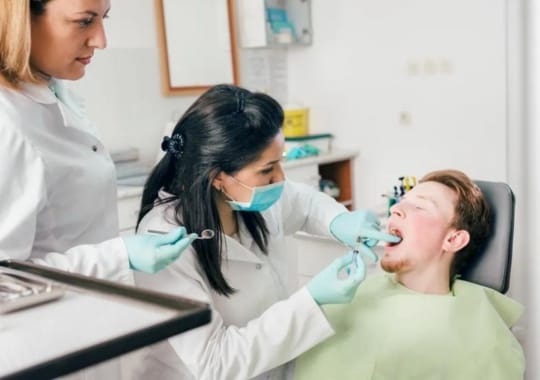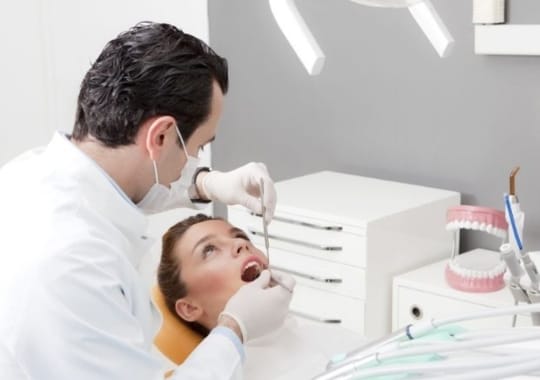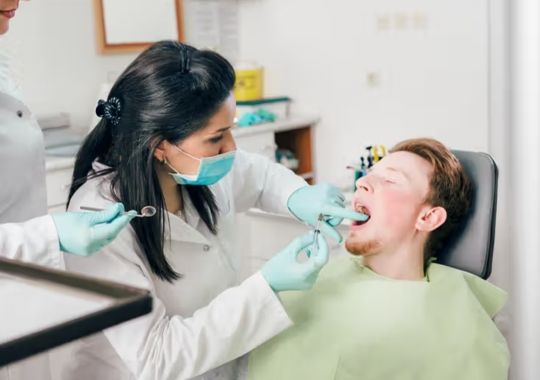Can You Eat with a Temporary filling. A common dental treatment used to protect and restore damaged teeth. If you've recently received a temporary filling, you might be wondering if it's safe to eat with it. In this article, we will explore the topic of eating with a temporary filling, understand the purpose of temporary fillings, and highlight their importance in dental care.
As Amazon affiliates we may earn a commission if you purchase a product at no cost to you.

Do's & Don'ts after a Dental filling. Watch this great video.
Can You Eat with a Temporary Filling?
If you have a temporary filling, you might be wondering about its impact on your eating habits. Let's delve into whether it is safe to eat with a temporary filling, along with some food recommendations and foods to avoid.
The Function of Temporary Fillings
Temporary fillings are designed to provide a protective barrier for the damaged tooth, but they have certain limitations. While they can withstand normal chewing forces, they are not as strong or durable as permanent fillings. Temporary fillings are more prone to wear, dislodgment, or damage when exposed to excessive force or specific types of foods.
Food Recommendations with Temporary Fillings
While it is generally safe to eat with a temporary filling, it is advisable to follow some food recommendations to minimize the risk of complications. Consider the following tips:
Soft foods: Opt for softer foods that are gentle on your teeth and easier to chew. Examples include mashed potatoes, soups, yogurt, cooked vegetables, and tender meats.
Cut food into smaller pieces: If you're eating something harder or more challenging to chew, cut it into smaller, manageable pieces to reduce the strain on your temporary filling.
Chew on the opposite side: If your temporary filling is on one side of your mouth, try to chew food on the opposite side to minimize pressure on the filling.
Foods to Avoid with Temporary Fillings
While enjoying a meal with a temporary filling, it is important to avoid certain types of foods that can potentially damage or dislodge the filling. Here are some foods to avoid:
Sticky foods: Sticky candies, toffees, or chewing gums can stick to the temporary filling and pull it out or cause damage.
Hard or crunchy foods: Foods like hard candies, nuts, popcorn, and ice can put excessive pressure on the temporary filling and increase the risk of dislodgment or fracture.
Extreme temperature foods: Extremely hot or cold foods and beverages can cause sensitivity in the tooth with the temporary filling. It's best to consume them in moderation or at a more moderate temperature.

Temporary Fillings
Temporary fillings, also known as interim fillings, are a short-term solution used to address various dental issues. They are typically made of different materials, such as dental cement or temporary filling compounds. Unlike permanent fillings, temporary fillings are not intended to last for an extended period.
Temporary fillings serve as placeholders until a permanent restoration, such as a dental crown or composite filling, can be placed. They provide temporary relief by sealing the tooth, protecting it from further damage or infection, and reducing sensitivity.
Importance of Temporary Fillings
Temporary fillings play a crucial role in maintaining oral health and preventing complications. Here are some key reasons why temporary fillings are important:
Protection: Temporary fillings act as a barrier, shielding the exposed tooth structure from bacteria and debris. By preventing further damage, they help maintain the integrity of the tooth until a permanent restoration can be performed.
Preservation: Temporary fillings help preserve the remaining tooth structure, allowing for proper function and aesthetics while the final restoration is being prepared.
Pain relief: Temporary fillings can alleviate sensitivity and discomfort caused by exposed nerves or tooth decay. They provide temporary relief until the permanent restoration can address the underlying cause of the pain.
Stabilization: In cases where multiple dental visits are required for complex procedures, temporary fillings help stabilize the tooth and prevent shifting or further damage until the final treatment is completed.
It's important to understand that temporary fillings have limitations and should not be considered a long-term solution. They are temporary measures that require timely replacement with permanent restorations to ensure optimal oral health.
How Long Can You Eat After Getting a Temporary Filling?
After getting a temporary filling, it's important to be mindful of your eating habits to ensure the longevity and stability of the filling. Here are some key considerations regarding how long you can eat after getting a temporary filling:
Initial Sensitivity and Numbness
Immediately after getting a temporary filling, you may experience some sensitivity or numbness in the treated area due to the dental procedure. This is normal and temporary. The duration of this sensitivity can vary from person to person, but it typically subsides within a few hours to a couple of days.
During this initial period, it's best to avoid eating until the numbness wears off completely. This helps prevent accidental bites or injury to your lips, cheeks, or tongue.
Resuming Normal Eating Habits
Once the numbness wears off and any initial sensitivity diminishes, you can gradually resume your normal eating habits. However, it's important to keep in mind the limitations of a temporary filling and follow the food recommendations mentioned earlier.
While you can eat with a temporary filling, it's advisable to be cautious with your eating habits. Take smaller bites, chew slowly, and be mindful of the amount of pressure you apply while chewing. This helps minimize the risk of dislodging or damaging the temporary filling.
Signs of Complications While Eating
While eating with a temporary filling, it's essential to pay attention to any signs of complications. These may include:
Persistent pain: If you experience ongoing pain or discomfort while eating, it could indicate an issue with the temporary filling or the underlying tooth. Contact your dentist if the pain persists or worsens.
Filling dislodgment: If you feel the temporary filling shifting, coming loose, or completely falling out while eating, avoid chewing on that side and contact your dentist immediately. Do not try to reposition the filling yourself.
Sensitivity or sharp pain: If you encounter sudden sensitivity or sharp pain in the tooth with the temporary filling while biting down on food, it could be a sign of damage or an issue with the filling. Seek dental attention to evaluate the situation.
By being aware of these signs and promptly addressing any complications, you can ensure the continued effectiveness of the temporary filling and prevent further dental problems.
Tips for Eating with a Temporary Filling
To ensure the longevity and stability of your temporary filling while enjoying your meals, here are some helpful tips to keep in mind:
Chewing on the Opposite Side
When eating with a temporary filling, try to chew your food on the opposite side of your mouth. This helps minimize the pressure and strain on the side with the filling, reducing the risk of dislodgment or damage.
By consciously shifting the chewing to the unaffected side, you can ensure that the temporary filling remains secure and undisturbed during the process of eating.
Taking Small Bites and Chewing Slowly
To prevent unnecessary stress on the temporary filling, it's advisable to take smaller bites and chew your food slowly. This allows for better control and reduces the risk of accidentally biting down with excessive force.
By taking your time and thoroughly chewing your food, you can minimize the chances of dislodging or damaging the temporary filling while enjoying your meals.
Rinsing After Meals
After eating, it's a good practice to rinse your mouth with water or an antibacterial mouthwash. This helps remove any food particles or debris that may have accumulated around the temporary filling.
Rinsing also helps maintain oral hygiene and reduces the risk of bacteria build-up, which can contribute to decay or infection. However, avoid vigorous rinsing, as it may dislodge the temporary filling.

What Happens If You Eat Sticky or Hard Foods with a Temporary Filling?
Consuming sticky or hard foods with a temporary filling can pose risks to the stability and integrity of the filling.
Risk of Dislodging the Filling
Sticky foods, such as chewy candies, toffees, or caramel, have a tendency to stick to dental restorations, including temporary fillings. When you eat these sticky foods, there's a risk of dislodging the filling or pulling it out entirely.
The adhesion of sticky foods can create significant force, potentially causing the temporary filling to loosen or break away from the tooth structure. If the filling becomes dislodged, it exposes the tooth to bacteria and increases the risk of decay or infection.
Potential Damage to the Filling or Tooth
Hard foods, like hard candies, nuts, popcorn kernels, or ice cubes, can exert excessive pressure on a temporary filling. This pressure can cause the filling to crack, chip, or break, compromising its effectiveness.
Eating hard foods with a temporary filling can also lead to damage or fracture of the underlying tooth structure. The force from biting down on hard substances can weaken the tooth and potentially result in the need for more extensive dental treatment.
Importance of Careful Food Choices
Careful food choices are crucial when you have a temporary filling. Avoiding sticky or hard foods significantly reduces the risk of dislodging the filling or damaging the tooth. By opting for softer and more tooth-friendly options, you can help maintain the integrity of the temporary filling and protect your oral health.
It's important to note that these food recommendations are applicable during the period you have a temporary filling in place. Once the temporary filling is replaced with a permanent restoration, you can gradually reintroduce a wider range of foods into your diet.
How to Care for a Temporary Filling While Eating
Taking proper care of your temporary filling while eating can help maintain its longevity and ensure optimal oral health. Here are some essential steps to follow:
Conclusion
In summary, when you have a temporary filling, it's crucial to be cautious with your food choices. Avoid hard, sticky, or chewy foods that could dislodge the filling. Stick to softer foods and chew on the opposite side of the mouth to prevent damage. Maintain good oral hygiene and follow your dentist's guidance for the filling to stay secure until the permanent one is placed.
Recommended Article

Frequently Asked Questions FAQs
Can I eat normally with a temporary filling?
Yes, you can eat with a temporary filling, but it's important to be mindful of your food choices and follow proper care guidelines. Avoid sticky or hard foods that can dislodge or damage the filling.
How long can I eat after getting a temporary filling?
You can eat shortly after getting a temporary filling once any initial sensitivity or numbness wears off. However, it's advisable to take smaller bites, chew slowly, and avoid applying excessive pressure on the filling.
What should I do if my temporary filling falls out while eating?
If your temporary filling falls out, remain calm and contact your dentist to schedule an appointment. Avoid self-replacement and bring the dislodged filling, if possible, for evaluation. Prompt dental care is important to prevent complications and determine the appropriate treatment.











